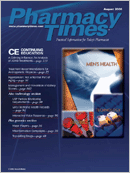Publication
Article
Pharmacy Times
Lifestyle Change or Medication for Diabetes Prevention?
Diabetes currently affects an estimated171 million individualsworldwide.1 In the United States,diabetes is the fifth leading cause of deathand was responsible for an estimated$132 billion in direct and indirect costs in2002.2 With a doubling of the cases of diabetesworldwide expected by 2030, thereis an urgent need to discover effectiveprevention strategies.1
The US Department of Health andHuman Services and the AmericanDiabetes Association (ADA) now use theterm "prediabetes" to describe anincreasingly common condition in whichblood glucose levels are higher than normalbut do not indicate diabetes asreflected by impaired glucose tolerance(IGT) or impaired fasting glucose. Studieshave shown that people with prediabetesare likely to develop type 2 diabetes within10 years unless they make changes intheir diet and level of physical activity.3
Does Early Pharmacotherapy Makea Difference?
Several oral hypoglycemic agents havebeen studied for the primary preventionof type 2 diabetes, with varying results.Pharmacologic therapy may offer a preventionoption for patients who eitherare unsuccessful with lifestyle interventionsor are unable to undertake the rigorsof diet and exercise.
Biguanides
The largest trial of a pharmacotherapeuticagent was the Diabetes PreventionProgram, which randomized3234 patients with elevated fasting andpostload plasma glucose to treatmentplacebo, metformin 850 mg twice daily, orintensive lifestyle intervention.4 After amean follow-up period of 2.8 years, theincidence of diabetes was reduced by58% with lifestyle intervention and by31% with metformin use, as comparedwith placebo. Metformin was most effectivein younger age groups and in patientswho were significantly overweight. It wasineffective in patients >60 years of age.Other studies using biguanides found nosignificant reduction in the incidence ofdiabetes, compared with placebo, butthese studies had low diabetes incidencerates and were likely underpowered toshow significant benefit.5,6
Acarbose
Acarbose was studied as a preventiveagent in the Study to Prevent Non-insulinDependent Diabetes Mellitus (STOPNIDDM)trial. This study showed a relativerisk reduction for the development ofdiabetes in the acarbose group after the39-month study period. Yet, 25% of thestudy population discontinued therapyearly, largely because of acarbose-inducedgastrointestinal toxicity.7
Sulfonylureas
Two studies examined the effect oftolbutamide therapy on the incidence ofdiabetes in patients with IGT or high-normalto elevated fasting glucose levels.8,9Neither study reported a statistically significantdecrease in the incidence of type2 diabetes. Both studies were small andpotentially underpowered, however.Glimepiride and gliclazide currently areunder study for primary prevention.
Thiazolidinediones
The Troglitazone Prevention ofDiabetes (TRIPOD) study showed a decreasein diabetes incidence from 45% to20% in high-risk Hispanic women usingtroglitazone.10 It is difficult to draw conclusionsbased on this study, however,because investigators were able toassess incidence of diabetes during thefollow-up period in only approximatelyone half of eligible patients. Rosiglitazonewith or without ramipril is currently underinvestigation as a preventive regimen.
Outlook
Although decreases in the incidence ofdiabetes were seen in some preventionstudies, the data are far from clearly supportingthe use of any of the studieddrugs as preventive agents. The ADA hasissued a position paper on the use ofpharmacologic therapy for diabetes prevention.11 Based on the available evidence,it concludes that "there is insufficientevidence to support the use of drugtherapy as a substitute for, or routinelyused in addition to, lifestyle modificationto prevent diabetes. Until there are studiesshowing that drugs will delay or preventthe complications of diabetes, oruntil the cost-effectiveness of using pharmacologicalagents has been established,we do not recommend the routine use ofthese agents to prevent diabetes."
Patients who are prediabetic need tobe aware of the significant benefits oflifestyle modification. Current recommendationsinclude decreasing body weightby at least 5%, limiting fat intake to 30%of calories, limiting saturated fat intake to<10% of calories, increasing fiber to atleast 15 g/1000 calories, and exercising atleast 150 minutes/week. Meeting thesegoals can reduce the incidence of progressionto diabetes by 58%.4
Dr. Garrett is a clinical pharmacistpractitioner at Cornerstone HealthCare in High Point, NC.
For a list of references, send a stamped,self-addressed envelope to: ReferencesDepartment, Attn. A. Rybovic, PharmacyTimes, Ascend Media Healthcare, 103 CollegeRoad East, Princeton, NJ 08540; or send anemail request to: [email protected]

Newsletter
Stay informed on drug updates, treatment guidelines, and pharmacy practice trends—subscribe to Pharmacy Times for weekly clinical insights.






